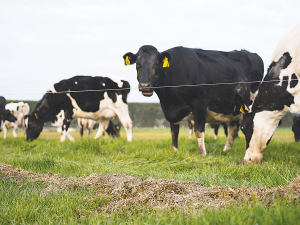Early summer stress risks dairy cow pregnancy success
By the time you are reading this, most spring-calving herds will have finished the main mating period.
 The three weeks before and after calving will set up the cow’s reproductive system for the whole season.
The three weeks before and after calving will set up the cow’s reproductive system for the whole season.
By September, most herds are already calved and are heading towards mating. The window to influence pre-calving minerals has passed, and decisions made in the transition period are only just becoming obvious.
How well the cows cycle, express heats, and conceive this spring is a direct reflection of the mineral balance they received during the allimportant transition period.
Watching for and understanding those signals now can help farmers improve outcomes for the rest of this season and build a better plan for next year.
Why transition still matters now
The three weeks before and after calving will set up the cow’s reproductive system for the whole season. Mineral imbalances in that window, even when clinical milk fever and ketosis may not have been evident, can lead to silent heats, delayed cycling, or low submission rates months later.
By the time mating starts, those imbalances can’t be completely undone. But they can be measured, managed, and used to improve both current and future mating performance.
What to look for in the herd
1. Heat expression
Weak or silent heats can indicate trace element imbalances, particularly copper and selenium, which influence hormone production and uterine repair. If heat activity seems low despite good energy levels, it’s worth checking mineral status.
2. Cycling patterns
Delayed cycling, cows not showing heats by the planned start of mating, often stems from mineral- related disruptions to ovarian function. These cows often look healthy, but are hormonally behind.
3. Retention of late-calvers
Cows calving late are already under pressure to get back in-calf. Any mineral issues from transition can compound that challenge. Tracking latecalvers’ heat activity can help flag if minerals were part of the problem.
Checking mineral status now
Blood tests taken in early lactation that assess both mineral status and liver function enzymes can show whether transition minerals have been adequately dosed. While this won’t change what’s already happened pre-calving, it does two things: Firstly, it guides supplementation during mating, i.e., correcting copper or selenium levels to support conception now, and secondly, it informs next year’s dry cow and transition plan, avoiding the same gaps repeating.
Pasture and feed tests are useful, but they don’t always reflect what cows absorbed. Liver testing gives the clearest picture of trace element reserves heading into mating.
Managing reproduction for the rest of this season
While pre-calving minerals can’t be changed at that late stage, there’s still value in supporting cows through mating:
Targeted trace elements: If testing shows low levels, supplementing during mating can help improve conception rates later.
Body condition checks: Thin cows take longer to cycle. Although minerals won’t fix this, knowing which cows are behind helps prioritise management.
Focus on heat detection: Heats can be harder to spot when expression is weak. Supplementing with key trace elements such as iodine and selenium supports increased thyroid hormone production, which in turn stimulates better liver function, leading to stronger heats and better conception.
Learning for next season
The biggest gain from monitoring now is in planning ahead. If low heat expression or late cycling is widespread, it’s a signal that transition nutrition, especially minerals, needs reviewing.
Questions to ask:
Answering these helps build a more accurate mineral plan for the next dry period, reducing the risk of repeat issues.
Why it pays to act on the signals
Poor reproduction is expensive, with more empties, late-calvers, and replacements to rear. Earlier conceptions tighten the calving pattern, boost days in milk, and reduce workload. Fixing mineral gaps doesn’t just avoid metabolic disease, it also improves fertility and herd longevity.
For many farms, even a modest lift in first-round in-calf rates translates to significant gains in milk and fewer headaches at mating time.
This spring, watch how cows are cycling. Weak heats or slow returns aren’t just bad luck; they’re a message from last season’s mineral management. The sooner that message is understood, the better decisions can be made for the season ahead.
Chris Balemi is founder of Agvance
The Coalition Government will need the support of at least one opposition party to ratify the free trade deal with India.
Primary sector leaders have welcomed the announcement of a Free Trade Agreement between India and New Zealand.
At Pāmu’s Kepler Farm in Manapouri, mating has wrapped up at the across-breed Beef Progeny Test.
More than 150 people turned up at Parliament recently to celebrate the 20th anniversary of Horticulture New Zealand (HortNZ).
Biosecurity New Zealand says Kiwis should continue to keep an eye out for yellow-legged hornets (Vespa velutina) over the holiday season.
Fonterra has slashed another 50c off its milk price forecast as global milk flows shows no sign of easing.
President Donald Trump’s decision to impose tariffs on imports into the US is doing good things for global trade, according…
Seen a giant cheese roll rolling along Southland’s roads?